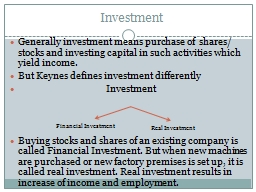

But Keynes defines investment differently Investment Buying stocks and shares of an existing company is called Financial Investment But when new machines are purchased or new factory premises is set up it is called real investment Real investment results in ID: 1028299
Download Presentation The PPT/PDF document "Investment Generally investment means pu..." is the property of its rightful owner. Permission is granted to download and print the materials on this web site for personal, non-commercial use only, and to display it on your personal computer provided you do not modify the materials and that you retain all copyright notices contained in the materials. By downloading content from our website, you accept the terms of this agreement.
1. InvestmentGenerally investment means purchase of shares/ stocks and investing capital in such activities which yield income.But Keynes defines investment differently InvestmentBuying stocks and shares of an existing company is called Financial Investment. But when new machines are purchased or new factory premises is set up, it is called real investment. Real investment results in increase of income and employment.Financial InvestmentReal Investment
2. Definitions of InvestmentAccording to Stonier and Hague, “ By investment we do not mean the purchase of existing paper security, bonds, debentures or equity, but the purchase of new factories, machines and like.Best definition is by Peterson. He says, “ Investment expenditure includes expenditure for producer’s durable equipment, new construction and the change of inventories.”
3. Classification of Investment InvestmentInduced InvestmentAutonomous investmentPrivate InvestmentPublic InvestmentGross InvestmentNet InvestmentIntended/Ex-ante/Planned/voluntary InvestmentUnintended/Ex-post/Unplanned/Involuntary Investment
4. Induced InvestmentSuch investment is governed by income and profit. So it is income or profit elastic. Prof Kieser says, “ When an increase in investment is due to increase in current level of income and production, it is known as induced investment.Prof Kurihara says that at very low levels of income this investment may be negative.InvestmentIncomeYXII
5. Autonomous investmentIt is independent of level of income or output. It is made with the aim of introducing new techniques, new inventions etc.Such investment is made for economic development or defence sector of the country.IncomeInvestmentXoYII
6. Private InvestmentPublic InvestmentMade by private individuals with the aim of profits.Depends on MEC and rate of interestIf MEC is greater than R more investment will be made. Otherwise no investment. Also known as induced investmentIt is made by the government of the country. Objective: Welfare of people, defence of country and economic development.Not profit induced
7. Gross InvestmentNet InvestmentThe total expenditure incurred on capital goods at any given time in a economyGI= Net I+ Replacement IPeterson says, “ Replacement investment is that investment which maintains intact a given stock of capital.It is that investment as a result of which there is increase in capital stock.Peterson-net investment is investment that enlarges economy’s stock of real capital assets thereby adding to productive capacity.t
8. Ex-ante InvestmentEx-post InvestmentIt is made voluntarily, according to definite plan, to achieve a given objective.Such investment is generally done by government to achieve the target of employment generation of economic growth.It is done involutarily by investors. Many a times due sudden fall in demand the stocks may plummet. So investment in such stocks is against will of investor.
9. Average Propensity to InvestMarginal Propensity to InvestIt is the ratio of total investment to total income.API=I/YIt is the ratio of change in investment to change in incomeIf income increases by rs 10 crore and as a result investment increases by 5 crore, then MPI=5/10=.5Propensity to Invest ( I/Y)
10. Determinants of induced investmentIn private sector, inducement to invest is influenced by two determinants- MEC and rate of interestMEC: It stands for expected rate of profitabilty when one more unit of capital is employed. MEC depends upon two factors- Prospective yield and supply priceProspective yield: PY is calculated by aggregating net income of every year of a machine through out its life time. To estimate net income, cost is deducted from annual output of machine.Supply Price: It is the cost of the machine. But not the cost of existing machine but that of a brand new machine.
11. MEC can be found by deducting supply price from PY. As supply remains fixed, so MEC is more influenced by PY which is uncertain.Rate of Interest: “Interest is the reward for parting with liquidity” Keynes. Higher the rate of interest, greater will be the keenness on the part of people to part with liquidity. LP also affects rate of interest. Greater the LP, higher will b the rate of interest.
12. Every entrepreneur compares MEC with rate of interest while making investment. He will make investment if MEC is greater than rate of interest. If they are equal, it will be breakeven point.InvestmentMEC & rate of interestOYxMEC=REMECRR
13. Factors affecting investmentTechnological Advancement and innovationDiscovery of natural resourcesGovernment policiesForeign tradePolitical EnvironmentExpectationsRate of population growthTerritorial ExpansionThe price levelThe market structureAvailability of financeConditions in the labour marketAggregate Demand
14. Private InvestmentPublic InvestmentReduction in rate of interestReduction in taxes 0f wage cutIncrease in govt. expenditurePrice support policyPromotion of researchPump pricingTaxationLoansDeficit financingMeasures to stimulate Investment